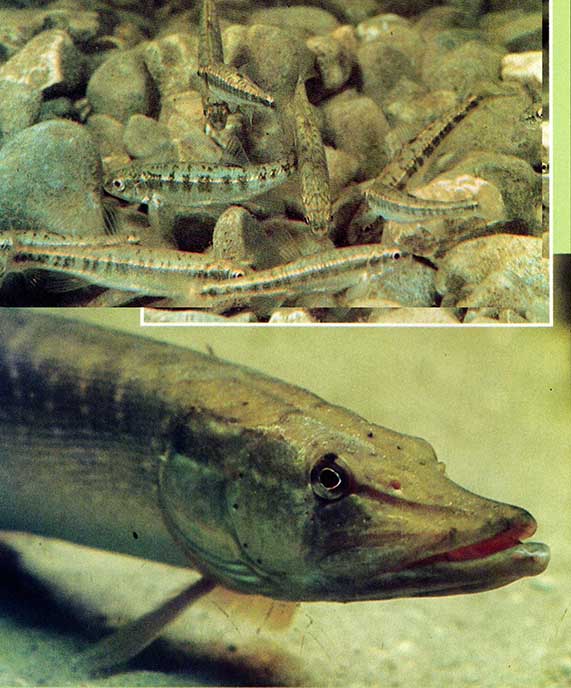 Ryby żyjące stadnie ostrzegają się nawzajem za pomocą tak zwanych substancji alarmowych. Szczupaki doskonale o tym wiedzą.
Ryby żyjące stadnie ostrzegają się nawzajem za pomocą tak zwanych substancji alarmowych. Szczupaki doskonale o tym wiedzą.
Jeżeli szczupak lub jakiś inny drapieżnik zaatakuje i zrani strzeblę potokową, ryba ta natychmiast wydziela do wody substancję alarmową. Feromon ten jest ostrzeżeniem przed grożącym niebezpieczeństwem dla wszystkich strzebli w najbliższej okolicy. Zaledwie substancja ta znajdzie się w wodzie, wszystkie ryby ze stada natychmiast chowają się, gdzie popadnie.
Kanadyjscy naukowcy badający mechanizmy zachowania się ryb ustalili ostatnio, że feromon wydzielany przez strzeble nie traci swych właściwości alarmujących nawet po przejściu przez żołądek oraz jelita szczupaka. Mało tego – wszystko wskazuje na to, że szczupaki doskonale o tym wiedzą. Substancję alarmową udało się wydzielić także z odchodów drapieżników i okazało się, że nie straciła ona nic ze swych właściwości. Trzech naukowców z Uniwersytetu Saskatchewan prowadziło w olbrzymich akwariach dokładne obserwacje szczupaków i ryb stanowiących ich pokarm. Z opublikowanych później opracowań wynika, że wszystkie strzeble natychmiast rzucały się do panicznej ucieczki, gdy tylko w wodzie znalazły się odchody jakiegoś szczupaka, który zjadł wcześniej właśnie strzeblę. Szczupaki trzymane były w osobnym akwarium, jednak już same odchody któregoś z drapieżników wystarczyły, aby wywołać w stadzie strzebli całkowitą panikę.
Jeżeli szczupaki wcześniej odżywiały się innymi gatunkami ryb, w zachowaniu strzebli nie zaobserwowano żadnych zmian. Po wpuszczeniu ich do akwarium ze szczupakami rybki bez obaw pływały pomiędzy stojącymi w bezruchu drapieżnikami.
To zadziwiające, ale wydaje się, że szczupaki instynktownie wyczuwają, że ich odchody zawierają substancję alarmową ostrzegającą ryby, na które polują. Naukowcy zaobserwowali bowiem, że w długim, ale wąskim akwarium, drapieżniki wypróżniały się zawsze w jednym i tym samym rogu. Szczupaki zazwyczaj trzymały się w jednym końcu akwarium, defekacja zaś odbywała się zawsze w drugim końcu akwarium. Dzięki temu substancja alarmowa wyprodukowana przez strzeble znajdowała się możliwie jak najdalej od „stanowisk łowieckich” głodnych szczupaków.
Kanadyjscy naukowcy przypuszczają, że szczupakom po prostu opłaca się bycie „przyzwoitymi”, gdyż tylko dzięki temu nie ostrzegają swych potencjalnych zdobyczy – przynajmniej w akwarium.
Jak odkryto substancję alarmową
Profesor zoologii Karl von Frisch odkrył istnienie substancji alarmowych u ryb stadnych już ponad pięćdziesiąt lat temu. Dzięki regularnemu nęceniu w pewnej zatoce jeziora Wolfgang dość szybko przyzwyczaił do swojej obecności duże stado strzebli. Pierwotnie zoolog chciał tylko obserwować różne zachowania ryb żyjących stadnie. Do tego celu niezbędne było jednak oznakowanie pojedynczych strzebli. Karl v. Frisch odkrył wcześniej, że po przecięciu pewnego nerwu płetwa odbytowa strzebli staje się znacznie ciemniejsza. Ciemne płetwy były bardzo dobrym oznakowaniem.
Lekkie skaleczenie było całkowicie niegroźne dla ryby, a strzebla „po zabiegu” od razu dołączała do stada. Zoolog dokonał jednak przy okazji zadziwiającego odkrycia -ledwie lekko skaleczona ryba wracała do wody, całe stado strzebli rzucało się do panicznej ucieczki. O ufności i przywiązaniu do systematycznie nęconego miejsca nie było nawet mowy. Powyższe zachowanie się ryb naprowadziło badacza na właściwy ślad. Dopiero później odkryto, że substancje alarmowe produkowane są w specjalnych komórkach naskórka. Ryba wydziela feromon alarmowy w momencie zaatakowania jej przez drapieżnika. Dzięki sekrecji tej substancji schwytana ryba nie ma oczywiście szans na ratunek, ale dla pozostałych ryb w stadzie jest to sygnał decydujący często o życiu lub śmierci.








